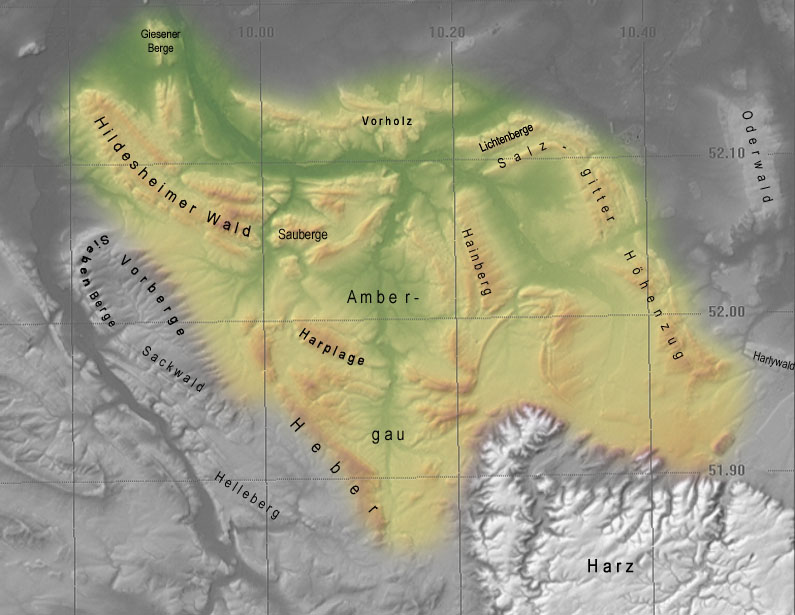|
Giesen Hills
The Giesen Hills (german: Giesener Berge) are a ridge, up to 242.5 metres high, in the district of Hildesheim in the German state of Lower Saxony. Geography The ridge of the Giesen Hills is located in the extreme north of the Innerste Uplands, a northeastern element of the Lower Saxon Hills. It lies between sections of the River Innerste to the east and the River Leine to the west, north of Himmelsthür (northwest of Hildesheim) and south of Giesen. Description The Giesen Hills reach their highest point in an unnamed summit, 162.6 metres high. The wooded northern part of the ridge is crossed by a few footpaths and forest tracks. Towards the east the land falls away to the Innerste, that flows close by the ridge from south to north. To the west the hills descend gradually towards the Leine, that runs past them, also in a south to north direction, some 6 kilometres away. Immediately adjacent to the Giesen Hills to the south is a local military training area, ... [...More Info...] [...Related Items...] OR: [Wikipedia] [Google] [Baidu] |
Landkreis Hildesheim
Hildesheim is a district (''Landkreis'') in Lower Saxony, Germany. It is bounded by (from the north and clockwise) the districts of Hanover, Peine, Wolfenbüttel, Goslar, Northeim, Holzminden and Hamelin-Pyrmont. History In 1885 the Prussian government established districts within the Province of Hanover. The present territory of the district was occupied by four districts: Hildesheim, Alfeld, Gronau and Marienburg. In 1932 the district of Gronau joined Alfeld, and the number of districts was reduced to three. When the state of Lower Saxony was founded in 1946, the districts were reorganised: Hildesheim became an urban district, the remaining district of Hildesheim and Marienburg were merged to the new district of Hildesheim-Marienburg. The district of Alfeld remained in its former borders. In 1974 the city of Hildesheim lost its status as an urban district and became part of the surrounding district, which was renamed to Hildesheim. The districts of Hildesheim and Al ... [...More Info...] [...Related Items...] OR: [Wikipedia] [Google] [Baidu] |
Lower Saxony
Lower Saxony (german: Niedersachsen ; nds, Neddersassen; stq, Läichsaksen) is a German state (') in northwestern Germany. It is the second-largest state by land area, with , and fourth-largest in population (8 million in 2021) among the 16 ' federated as the Federal Republic of Germany. In rural areas, Northern Low Saxon and Saterland Frisian language, Saterland Frisian are still spoken, albeit in declining numbers. Lower Saxony borders on (from north and clockwise) the North Sea, the states of Schleswig-Holstein, Hamburg, , Brandenburg, Saxony-Anhalt, Thuringia, Hesse and North Rhine-Westphalia, and the Netherlands. Furthermore, the Bremen (state), state of Bremen forms two enclaves within Lower Saxony, one being the city of Bremen, the other its seaport, Bremerhaven (which is a semi-enclave, as it has a coastline). Lower Saxony thus borders more neighbours than any other single '. The state's largest cities are state capital Hanover, Braunschweig (Brunswick), Lüneburg, ... [...More Info...] [...Related Items...] OR: [Wikipedia] [Google] [Baidu] |
Innerste Uplands
The Innerste Uplands (german: Innerstebergland) is a landscape region up to 359 m high and covering an area of over 900 km² in the northern part of the German Central Uplands. It lies within the eastern part of the Weser-Leine Uplands in Lower Saxony (Germany). The Innerste Uplands gets its name from the Innerste, a tributary of the River Leine. Geography Location The Innerste Uplands cover the catchment area of the Innerste southeast of Hildesheim and southwest to south of Salzgitter as far as Goslar and Seesen on the northwestern edge of the Harz. To the north the area is bounded by the Hildesheim Börde, to the west by the Leine Uplands and to the southeast by the North Harz Foreland. Its central and southern areas are dominated by the Ambergau, a depression dissected by the Nette, a tributary of the Innerste. In and around the Innerste Uplands there are the following clearly defined ridges, most of which are cuestas and some of which lie on the boundary with ... [...More Info...] [...Related Items...] OR: [Wikipedia] [Google] [Baidu] |
Lower Saxon Hills
The Lower Saxon Hills (german: Niedersächsisches Bergland) are one of the 73 natural regions in Germany defined by the Federal Agency for Nature Conservation (BfN). Geographically it covers roughly the same area as the Weser Uplands (german: Weserbergland) in its wider sense.However at least one source, Elkins (1968), uses the term to refer to the outcrops of rock to the north, west and southwest of the Harz which roughly corresponds to the eastern half of the BfN's region and extends only as far as the area between the rivers Weser and Leine. The region is part of Germany's Central Uplands with hills ranging up to in height that extend across northeast North Rhine-Westphalia, southern Lower Saxony and northern Hesse. It is classified as region number D 36 by the BfN; its full name being the ''Niedersächsisches Bergland (mit Weser- und Leine-Bergland'' (Lower Saxon Hills, including the Weser and Leine Hills). D 36 is a newly defined region that incorporates 3 geographical units f ... [...More Info...] [...Related Items...] OR: [Wikipedia] [Google] [Baidu] |
Innerste
The Innerste is a river in Lower Saxony, Germany. It is a right tributary of the Leine river and in length. Origin of the name The river name is not related to the German word ''innerste'' meaning innermost. ''Innerste'', in earlier times called the ''Inste'' (1805), ''Inderste'' (1567), ''Indistria'' (1313), ''Entrista'' (1065) and ''Indrista'' (1013), probably goes back to the Indo-Germanic root ''oid'' = ''turbulent, strong''. It may be the name referred to in the name of the battlefield of '' ''Idista''viso'' (16 A.D.). Course The river's source is in the Harz mountains, from the town of Clausthal-Zellerfeld to the southwest at an elevation of 615 m and is called ''Innerstesprung''. As a small brook, the Innerste flows west and passes a system of lakes, the first of which is called ''Entensumpf''. The next lakes are ''Oberer Nassenwieser Teich'', ''Bärenbrucher Teich'', ''Ziegenberger Teich'', and ''Sumpfteich''. The German word ''Teich'' means "pond". Having ... [...More Info...] [...Related Items...] OR: [Wikipedia] [Google] [Baidu] |
Leine (Aller)
The Leine (; Old Saxon ''Lagina'') is a river in Thuringia and Lower Saxony, Germany. It is a left tributary of the Aller and the Weser and is long. The river's source is located close to the town of Leinefelde in Thuringia. About downriver, the river enters Lower Saxony and runs northwards. Important towns along its course, from upstream to downstream, are Göttingen, Einbeck, Freden, Alfeld, and Gronau, before the river enters Hanover, the largest city on its banks. Downstream some north of Hanover, near Schwarmstedt, the river joins the Aller and reaches the North Sea via the Weser. Its northern (lower) reaches are only navigable today by the smallest commercial carriers, though in the past, it served as an important pre-railway barge transport artery as far upriver as Göttingen. The river is somewhat polluted by industry, so the water is not used for drinking, but the pollution has never been severe enough to prevent fish from living in it. Like many western rivers sin ... [...More Info...] [...Related Items...] OR: [Wikipedia] [Google] [Baidu] |
Himmelsthür
Hildesheim (; nds, Hilmessen, Hilmssen; la, Hildesia) is a city in Lower Saxony, Germany with 101,693 inhabitants. It is in the district of Hildesheim, about southeast of Hanover on the banks of the Innerste River, a small tributary of the Leine River. The Holy Roman Emperor Louis the Pious founded the Bishopric of Hildesheim in 815 and created the first settlement with a chapel on the so called ''Domhügel''. Hildesheim is situated on autobahn route 7, and hence is at the connection point of the North (Hamburg and beyond) with the South of Europe. With the Hildesheim Cathedral and the St. Michael's Church, Hildesheim became a UNESCO World Heritage Site in 1985. In 2015 the city and the diocese celebrated their 1200th anniversary. History Early years According to tradition, the city was named after its notorious founder ''Hildwin.'' The city is one of the oldest cities in Northern Germany, became the seat of the Bishopric of Hildesheim in 815 and may have been f ... [...More Info...] [...Related Items...] OR: [Wikipedia] [Google] [Baidu] |
Hildesheim
Hildesheim (; nds, Hilmessen, Hilmssen; la, Hildesia) is a city in Lower Saxony, Germany with 101,693 inhabitants. It is in the district of Hildesheim, about southeast of Hanover on the banks of the Innerste River, a small tributary of the Leine River. The Holy Roman Emperor Louis the Pious founded the Bishopric of Hildesheim in 815 and created the first settlement with a chapel on the so called ''Domhügel''. Hildesheim is situated on autobahn route 7, and hence is at the connection point of the North (Hamburg and beyond) with the South of Europe. With the Hildesheim Cathedral and the St. Michael's Church, Hildesheim became a UNESCO World Heritage Site in 1985. In 2015 the city and the diocese celebrated their 1200th anniversary. History Early years According to tradition, the city was named after its notorious founder ''Hildwin.'' The city is one of the oldest cities in Northern Germany, became the seat of the Bishopric of Hildesheim in 815 and may have ... [...More Info...] [...Related Items...] OR: [Wikipedia] [Google] [Baidu] |
Giesen
Giesen is a village and a municipality in the district of Hildesheim, in Lower Saxony, Germany. It is situated approximately 6 km northwest of Hildesheim, and 22 km southeast of Hanover Hanover (; german: Hannover ; nds, Hannober) is the capital and largest city of the German state of Lower Saxony. Its 535,932 (2021) inhabitants make it the 13th-largest city in Germany as well as the fourth-largest city in Northern Germany .... The municipality includes five villages: * Ahrbergen (pop. 2,219) * Emmerke (pop. 1,684) * Giesen (pop. 3,401) * Groß Förste (pop. 795) * Hasede (pop. 1,606) Gallery File:Gross Giesen Kirche.JPG, Gross Giesen, Sankt-Vitus-Kirche File:Ahrbergen, dorpszicht IMG 4613 2018-07-02 11.38.jpg, Ahrbergen, view to the village File:Gross Förste, die katholische Kirche Sankt Pankratius IMG 4626 2018-07-02 11.52.jpg, Gross Förste, catholic church: Kirche Sankt Pankratius File:Hasede, die Sankt Paulus Kirche IMG 4635 2018-07-02 12.02.jpg, ... [...More Info...] [...Related Items...] OR: [Wikipedia] [Google] [Baidu] |
Military Training Area
A military training area, training area (Australia, Ireland, UK) or training centre (Canada) is land set aside specifically to enable military forces to train and exercise for combat. Training areas are usually out of bounds to the general public, but some have limited access when not in use. As well as their military function, they often serve as important wildlife refuges. They are distinct from proving grounds which are designed for purposes such as testing weaponry or equipment. Description Military training areas are important because they enable troops to train more realistically and in greater numbers over a wide area without unduly inconveniencing the public or putting others at risk. They are particularly important for all arms training where the different elements of armed forces come together to cooperate and coordinate their fire and movement. Training areas often incorporate a variety of terrain types, including forests, heathland, waterbodies and farmland, as well a ... [...More Info...] [...Related Items...] OR: [Wikipedia] [Google] [Baidu] |
Normalnull
("standard zero") or (short N. N. or NN ) is an outdated official vertical datum used in Germany. Elevations using this reference system were to be marked (“meters above standard zero”). has been replaced by (NHN). History In 1878 reference heights were taken from the Amsterdam Ordnance Datum and transferred to the New Berlin Observatory in order to define the . has been defined as a level going through an imaginary point 37.000 m below . When the New Berlin Observatory was demolished in 1912 the reference point was moved east to the village of Hoppegarten (now part of the town of Müncheberg, Brandenburg, Germany Germany, officially the Federal Republic of Germany (FRG),, is a country in Central Europe. It is the most populous member state of the European Union. Germany lies between the Baltic and North Sea to the north and the Alps to the sou ...).S. German: ''Was ist "Normal-Null"?''. In: ''Physikalische Blätter'' 1958, vol 14, issue 2, ... [...More Info...] [...Related Items...] OR: [Wikipedia] [Google] [Baidu] |
Bundesstraße 6
The Bundesstraße 6 (abbr. B6) is a German federal highway running from Bremerhaven on the North Sea coast in a southeasterly direction through the states of Lower Saxony, Bremen, Saxony-Anhalt and Saxony to Görlitz on the Polish border. History East of Leipzig, the B6 (except of the ring roads around Meißen, Dresden and Bischofswerda) largely follows the historic course of the ''Via Regia Lusatiae Superioris'', part of the medieval ''Via Regia''. In 1937, the northwestern section of the former ''Reichsstraße 6'' (R6) was extended from Bremerhaven (Wesermünde) to Cuxhaven. Before World War II and the implementation of the Oder–Neisse line, the R6 road continued southeastwards from Görlitz via Hirschberg (present-day Jelenia Góra, Poland) and Schweidnitz (Świdnica) to the Silesian capital Breslau (Wrocław) and from there via Oels (Oleśnica) as far as the former Polish border near Groß Wartenberg (Syców). The sections between Görlitz/ Zgorzelec and ... [...More Info...] [...Related Items...] OR: [Wikipedia] [Google] [Baidu] |






